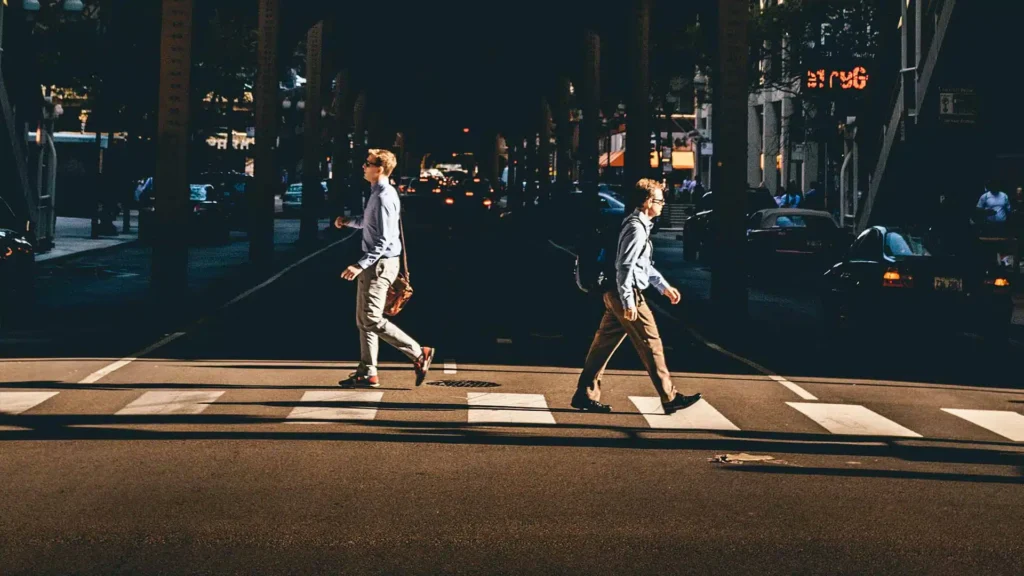Walking at night can be both peaceful and convenient, but it also comes with risks, particularly when crossing the street. Low visibility, distracted drivers, and poorly lit areas can all contribute to pedestrian accidents. In this blog, we’ll share important tips to help you stay safe while crossing the street at night.
1. Wear Bright or Reflective Clothing
One of the most effective ways to improve your visibility at night is by wearing bright or reflective clothing. Dark colors, while stylish, can make it much harder for drivers to see you, especially in low-light conditions. Opt for clothing with reflective strips or wear accessories like reflective vests or bands. This simple change can significantly reduce your chances of being overlooked by drivers.
2. Use Pedestrian Crosswalks
Always use designated crosswalks when crossing the street at night. These areas are usually well-marked and are designed with pedestrian safety in mind. Crosswalks often have pedestrian signals to help you time your crossing. When a crosswalk is not available, choose a well-lit intersection rather than crossing between parked cars or at random points along the street.
3. Stay Alert and Avoid Distractions
Walking while distracted by your phone or music can put you at significant risk. At night, your ability to hear approaching vehicles and see them from a distance is limited. Keep your headphones out and your phone in your pocket when crossing the street. Staying alert will allow you to notice any approaching vehicles, cyclists, or other potential hazards in your path.
4. Look Both Ways and Make Eye Contact
When crossing, always stop at the curb, look both ways, and wait for traffic to clear. Even when traffic lights or pedestrian signals indicate it’s safe to cross, you should still check for any approaching vehicles. Make eye contact with drivers before stepping into the street to ensure they see you. This extra step helps confirm that the driver is aware of your presence, especially at night when their visibility may be compromised.
5. Avoid Crossing in Poorly Lit Areas
Crossing in poorly lit areas increases your chances of being overlooked by drivers. If possible, choose streets or intersections that are well-lit, and avoid dark alleys or streets where visibility is limited. Lighting is crucial for both your safety and for drivers to see pedestrians clearly. If you must cross a poorly lit area, take extra care to look for approaching traffic before proceeding.
6. Wait for the Green Light or Walk Signal
If there are traffic signals, always wait for the green pedestrian signal or the green light to cross. Never try to cross when the traffic light is red or when there’s no pedestrian signal. Impatience can be dangerous, especially at night when drivers may not expect you on the road. Being patient will ensure you cross safely when it’s your turn.
7. Walk on Sidewalks Whenever Possible
Whenever possible, walk on sidewalks or designated pedestrian paths. Sidewalks provide a physical barrier between you and moving traffic, offering an extra layer of protection. If there are no sidewalks, walk as far to the side of the road as possible and face oncoming traffic so you can see vehicles approaching.
8. Stay Visible to Drivers
When walking on the street at night, make sure you are visible to drivers. Carry a flashlight or use the flashlight feature on your phone when walking in poorly lit areas. The additional light will not only help you see better but also increase your visibility to drivers. If you’re walking with a group, walk in a way that ensures you can all be seen by approaching traffic.
9. Avoid Alcohol and Drugs
Impaired walking is just as dangerous as impaired driving. Alcohol and drugs can impair your judgment, coordination, and reaction times, making it more difficult to cross the street safely at night. Avoid walking after drinking or using substances that could affect your ability to pay attention to your surroundings.
10. Be Extra Cautious in Bad Weather
Poor weather conditions like rain, fog, or snow can make it even harder for drivers to see pedestrians and for pedestrians to see traffic clearly. If you must walk in bad weather, exercise extra caution. Consider waiting until conditions improve or choose routes with better visibility and fewer hazards.
Conclusion
Walking at night doesn’t have to be dangerous as long as you take the right precautions. By being visible, alert, and mindful of traffic, you can significantly reduce the risks associated with nighttime street crossings. Remember to wear reflective clothing, use crosswalks, stay alert, and follow traffic signals. Your safety is in your hands, and with these tips, you can confidently navigate the streets at night.

